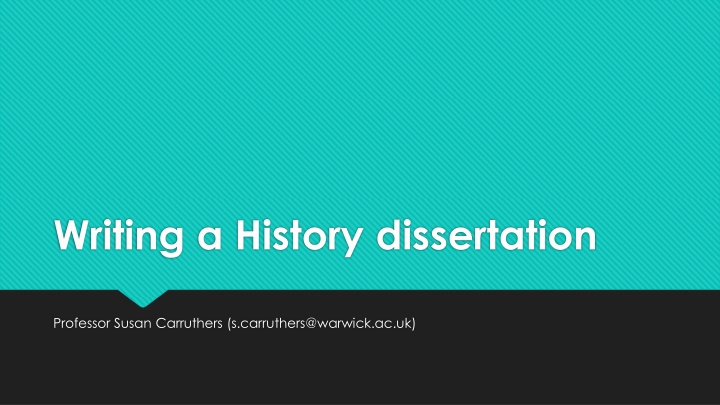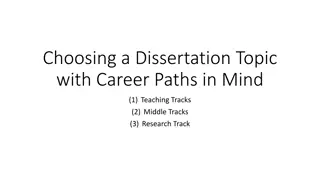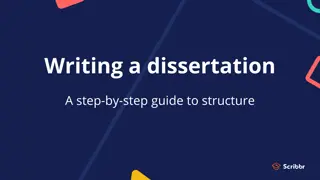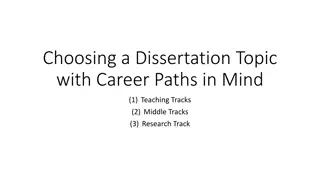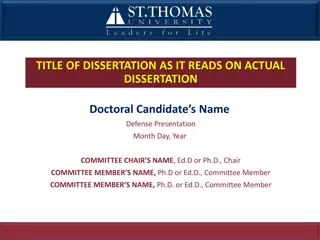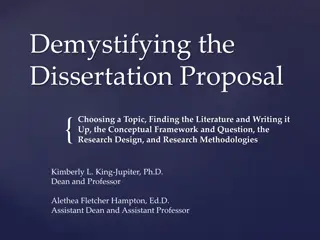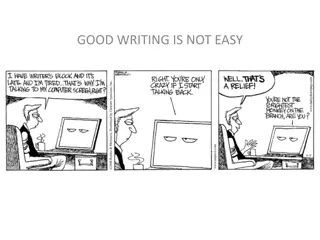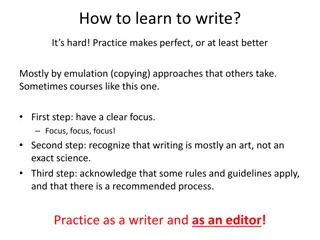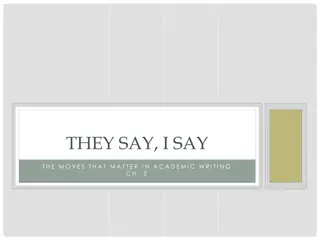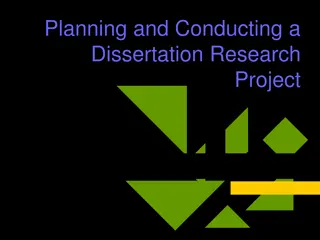Mastering the Art of Writing a History Dissertation
Dive into the world of history dissertation writing with insights from Professor Susan Carruthers. Understand the essence of a dissertation, from research to writing, and learn valuable tips for staying focused and organized throughout your academic journey.
Download Presentation

Please find below an Image/Link to download the presentation.
The content on the website is provided AS IS for your information and personal use only. It may not be sold, licensed, or shared on other websites without obtaining consent from the author.If you encounter any issues during the download, it is possible that the publisher has removed the file from their server.
You are allowed to download the files provided on this website for personal or commercial use, subject to the condition that they are used lawfully. All files are the property of their respective owners.
The content on the website is provided AS IS for your information and personal use only. It may not be sold, licensed, or shared on other websites without obtaining consent from the author.
E N D
Presentation Transcript
Writing a History dissertation Professor Susan Carruthers (s.carruthers@warwick.ac.uk)
A BIG task Very large books in the archives of Prague castle Photo by M. Peterka
Keep focused on the task in hand What a dissertation is (and isn t): A 9,000 word-long exploration of a tightly defined historical question, rooted in primary source evidence, but drawing on and contributing to existing scholarship in the relevant field(s) Think of the dissertation as essentially a scholarly journal article with all the professional trimmings NOT a PhD thesis or a book; and not a magazine feature, but a work of academic scholarship which will be judged according to recognised conventions About 35pp of double-spaced A4 (plus bibliography) Identify historical scholarship you ve found most engaging and use it as a model and inspiration Acknowledge the limitations and constraints you re working under but embrace this project as a very particular challenge from which you ll gain or enhance many useful capabilities: superior research skills; professional writing and editing skills; time-management
Research/writing TERM 2 Draft a condensed plan discuss Start drafting Intro Start drafting sections aim for a complete first draft by end of reading week Re-work all sections making sure the parts add up to a coherent whole Easter break: check notes and bibliography; proof read Revise for exams TERM I Locate relevant primary and secondary sources Analyse them; take good notes Constantly refine your research idea write an abstract and keep honing it Map possible plans for the dissertation Discuss tentative outline Complete bulk of research by end of Xmas break
The importance of good note-taking Organising your material Marshalling your thoughts on paper KEY: Differentiating your response to a source the ideas and associations sparked by it-- from the original source itself. Use your own words/language as much as possible If you re paraphrasing in your notes, be sure you clearly indicate that you re re-phrasing a source (which you will need to cite in footnotes if you use this material later) If you re directly copying a source even just a phrase here and there-- you MUST ensure that your notes reflect that this is a direct quote, not your paraphrase Good note-taking is the surest way to avoid inadvertent plagiariasm. Sloppiness is NOT a defense if you ve imported others language/ideas into your diss without attribution.
Take a short test Try Exercise 3 from this resource produced by the American Historical Association to see whether you ve correctly mastered the art of citation. https://www.historians.org/teaching-and- learning/teaching-resources-for-historians/plagiarism- curricular-materials-for-history-instructors/exercises
Sections Why organise your dissertation into sections? Helping you and your reader stay focused on the argument and the illustrative evidence Sub-titles How many?? No right number BUT it is possible to break the material into too many bitty fragments
Experiment with different possible plans Get creative! Brainstorm different ideas for how you might organise your dissertation Map out 2 or 3 different plans for the structure Chronological vs. thematic organisation How best to approach comparative topics Start playing with possible plans early stay flexible as your ideas develop Share plans with adviser
What does a good Introduction do? Succinctly sets out the historical question your dissertation poses Explains how you re demarcating the topic: why this period; this theme; why these sources Establishes the significance of your topic with reference to existing historiography. Whose work are you drawing on, and what kind of contribution does your diss aim to make? Engages the reader, making them eager to press on. Think hard about your opening hook. How will you draw readers into your topic? NB: the Introduction is the single most important piece of the diss. Give it space several pages (not 1 or 2)-- and time. It ll likely take more revision and re-drafting than anything else, but getting this right is critical to the overall success of your project.
And finally. The Conclusion aim to do more than just summarise your core argument What fresh lines of inquiry might your dissertation lead to? Are there larger associations or reverberations-- you might tease out? Make sure the conclusion is a well-developed final section not just a perfunctory paragraph or two with a tacked on , last-minute feel
Drafting, re-drafting and editing A key to success is allowing plenty of time to draft and re-draft sections, ensuring that the whole thing hangs together coherently with smooth transitions from one part to the next and clear sign- posting of your argument One vital skill involves becoming a superior editor of your own work. This is HARD But absolutely necessary to ensure that your argument is tight; that you avoid unnecessary padding or repetition; and that the evidence as skillfully selected as possible to make your case Some material will have to be left out And you re going to have to cut some of what you ve drafted in order to make the finished product better
If I had more time, I would have written a shorter letter.
Finding the right tone The dissertation is a particular exercise in writing ACADEMIC PROSE But what does that mean exactly? Your voice should aim to be informed and formal, but also engaging and lively Writing academic prose doesn t mean that your text should be stilted, pretentious, laden with buzz words nor does it mean that you should trash every other scholar in sight. Arrogance on the page as in real life is never an appealing quality Aim to write as clearly and freshly as possible Try reading out your draft work aloud. If your prose seems convoluted or some of the phraseology makes your toes curl go back and re-word it. Academic prose still has to sound recognisable as your own distinctive voice
Quoting To quote or not to quote? Use quotations judiciously when there s a good reason to introduce other voices than your own not for the sake of bulking up your footnote count Frequent short, pithy quotations expressive phrases-- are generally better than long block quotes that interrupt your flow When you quote someone else s words, it s generally preferable to announce in the text whose language you ve borrowed, rather than making readers look in your footnotes Don t try to let long quotes speak for themselves. They don t! It s your job as the author to tease out the significance of a quotation, making clear how it helps illustrate your case Remember that whether you re quoting a source directly or paraphrasing it, you need to provide a citation in your footnotes
Footnotes Why are historians such footnote fetishists? What purposes does footnoting serve? Adding texture and historical depth Engaging in intellectual exchange with other scholars Acknowledging your intellectual debts Showing exactly where you located your source material-- so that others could build on your work in their own research I.e. your notes should let anyone reading your dissertation reconstruct your research process
Footnote dos and donts Do keep footnotes brief, with only occasional longer quotes. Give full details of the source and, where applicable, the page number(s). Make sure to insert the superscript numeral indicating a note at the END of the sentence in question. This means the numbers won t always appear right next to the quotation marks. You can include more than one citation in a single footnote. But make sure you distinguish clearly what material in the text the citations refer to. Follow the Department style sheet carefully and consistently. https://warwick.ac.uk/fac/arts/history/students/modules/hi 203/resources/styleguide Don t use footnotes to cheat on the word count! Don t write long discursive notes. If you find yourself tempted, ask why? If the material is so important that it has to be included, then it probably belongs in the text itself. Don t pass off a source you encountered second- hand as though you saw it first-hand. That s cheating! Notes should ALWAYS reflect the exact location in which you found the material. And if that was in another scholar s work, your note needs to reference both the text you re quoting from AND the secondary source in which you found this source mentioned.
The bibliography This should include everything you PERSONALLY consulted but not those materials you encountered second-hand thanks to others scholarship. Include references to the latter but not the former Divide your bibliography into clearly marked SECTIONS Begin my listing the PRIMARY SOURCES you used. You can use subtitles (if you wish) to identify distinct archival collections, on-line resources, and/or different kinds of material consulted (e.g. newspapers, films, memoirs etc.) In the bibliography, you don t need to list individual newspaper stories you looked at; you can simply list the titles of different papers you consulted SECONDARY SOURCES should be listed alphabetically by author s surname
Proof-reading Make sure to give your dissertation a thorough read-through before submission. Ask a friend to read it for you too and return the favour Don t rely on the spellchecker to do this for you. It won t correct word substitutions Check the text AND the footnotes ensuring the latter are in place where they need to be, and are all properly (and consistently) formatted Professionalism in presentation really matters It ll be obvious to readers if you got lazy or bored or ran out of time and neglected to check your work before submission. And if a dissertation shows signs that its author gave up on it, that s not going to impress readers/markers So, why squander marks needlessly?
Submission! Don t wait until the 59th minute of the 11th hour. Late submissions are penalised. Rushed submission bang-up against the deadline-- is an invitation for catastrophe. (Oops. Wrong file uploaded!!! HELP!??!!???!!!) Make sure you upload the correct really and truly final version of your dissertation Be sure to have a good system in place for labeling your draft finals and for distinguishing the final end product from everything else HURRAH! You did it . The most challenging but also most rewarding and original piece of your undergraduate degree.
